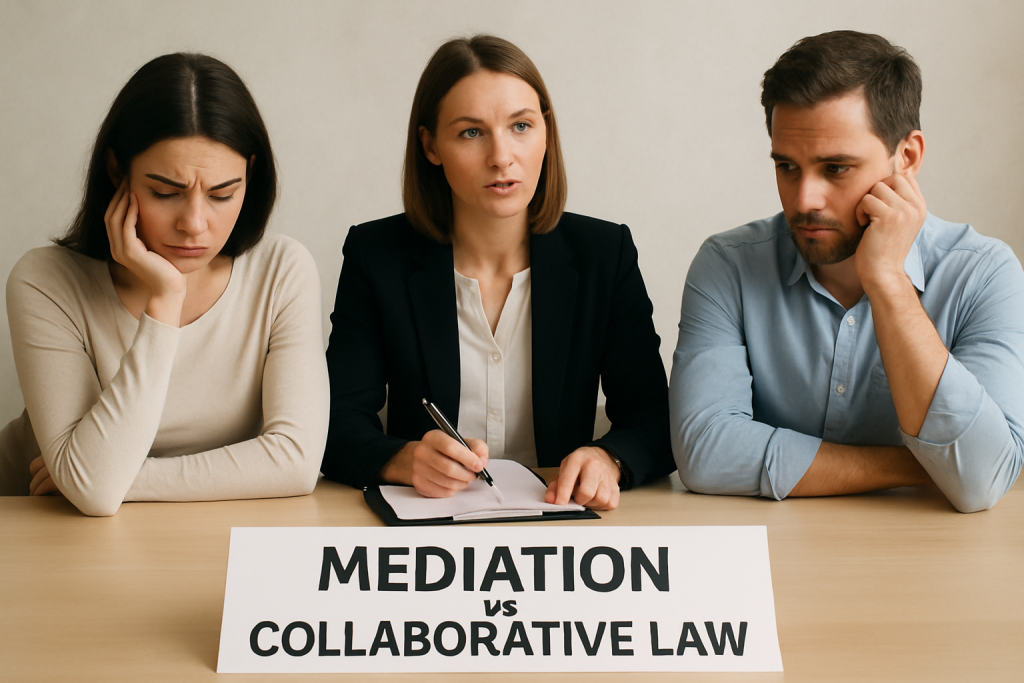When couples part ways amicably, choosing the right legal process matters just as much as reaching a peaceful agreement. In uncontested divorces, two methods often arise as frontrunners: mediation vs collaborative law. While both aim to resolve divorce issues without courtroom battles, each follows a distinct path, carries different legal dynamics, and influences outcomes in unique ways.
Couples considering divorce without conflict may assume either route leads to the same result. Yet understanding the subtle but significant differences between mediation vs collaborative law is essential for making an informed decision that protects financial stability, parenting plans, and emotional well-being.
This blog explores how mediation vs collaborative law compares in structure, privacy, cost, and legal control—helping you determine which option aligns with your uncontested divorce needs.
Understanding Mediation in Uncontested Divorce Cases
Mediation is a private dispute resolution process where divorcing spouses voluntarily meet with a neutral third party—a mediator—to discuss and settle key issues. The mediator does not represent either party and cannot impose decisions but instead facilitates structured communication.
In cases of uncontested divorce, mediation works well because the couple already agrees on most terms. They only need help refining or formalizing their agreement in a legally sound manner.
One key characteristic of mediation vs collaborative law is how legal counsel is used. In mediation, attorneys may advise clients outside the sessions but do not typically participate unless invited. This approach promotes a non-adversarial environment and allows for candid, open discussions.
When both spouses are willing to cooperate, mediation minimizes legal expenses and streamlines the divorce timeline. It also enables couples to maintain control over the outcome rather than leaving decisions to a judge.
The Collaborative Law Model in Divorce
Collaborative law, while also designed for peaceful resolution, operates through a more formalized structure involving legal representation for both parties from the outset. Each spouse hires an attorney specifically trained in collaborative practice.
Unlike traditional litigation, collaborative law prohibits courtroom involvement. All participants—spouses, attorneys, and sometimes financial or mental health professionals—sign a contract agreeing to resolve issues outside court.
One of the defining distinctions in mediation vs collaborative law is this contractual commitment. Should either party later decide to litigate, both attorneys must withdraw, and the couple must begin again with new legal representation. This agreement encourages full participation and discourages positional bargaining.
Collaborative law is often better suited for couples who want a more robust support team while still avoiding the courtroom. It provides a structured negotiation setting with continuous legal advice throughout the process.

Mediation vs Collaborative Law in Cost and Efficiency
Divorce costs can vary dramatically depending on the path chosen. In terms of financial efficiency, mediation vs collaborative law diverges in predictable ways.
Mediation is generally more cost-effective, especially when both spouses can communicate respectfully and focus on resolution. Since only one neutral mediator facilitates the process, the number of professionals involved is minimal, keeping expenses lower. Sessions can be scheduled as needed, with fewer formal procedures or preparatory costs.
In contrast, collaborative law involves multiple professionals—attorneys, financial consultants, mental health coaches—which naturally increases fees. The process, while still more affordable than litigation, carries higher costs than mediation due to its team-based approach and the need for legal preparation from the outset.
However, for couples with complex financial portfolios or parenting concerns, the extra cost may be justified by the level of support provided. Choosing between mediation vs collaborative law often depends on balancing budgetary limitations with the need for structured guidance.
Privacy Considerations in Mediation vs Collaborative Law
Divorce can expose sensitive personal and financial information. Couples seeking a private resolution often look to mediation vs collaborative law as ways to shield their affairs from public court records.
Both processes occur outside the courtroom, maintaining a high degree of confidentiality. Mediation records are generally not disclosed unless required by law or agreed upon by both parties. Discussions during mediation sessions remain private and inadmissible in court.
Similarly, collaborative law offers confidentiality. The contract signed at the start includes clauses protecting the disclosure of statements, documents, or negotiations within the process. This protection creates a safe environment where parties can speak freely without fear of future legal repercussions.
When privacy is a primary concern, either option offers a sound alternative to litigation. However, mediation may offer an extra layer of informality that some couples find preferable when handling deeply personal matters.
Legal Control and Decision-Making Power
The degree of legal control is a central point in the mediation vs collaborative law comparison. In mediation, control lies primarily with the spouses. They decide the terms, pacing, and outcome of their divorce. The mediator facilitates dialogue but never issues rulings.
This dynamic allows spouses to tailor agreements to their unique circumstances. Mediated settlements tend to reflect a couple’s shared priorities rather than a standardized legal formula. That autonomy can foster greater satisfaction and long-term compliance.
In collaborative law, the presence of attorneys ensures legal oversight and clarity. While the spouses still drive the decisions, attorneys advise on legal boundaries and help avoid pitfalls. This structure can benefit individuals less comfortable negotiating on their own or those concerned about power imbalances.
Although both models offer a cooperative framework, collaborative law injects more legal infrastructure, which may feel supportive or constraining depending on the couple’s preferences.

Duration and Flexibility in the Divorce Timeline
One of the greatest advantages in choosing mediation vs collaborative law is avoiding the prolonged timelines of court-based divorces. Yet differences in flexibility and duration exist between the two.
Mediation typically moves faster. Without rigid court schedules or multiple professionals to coordinate, couples can meet when convenient and settle issues within weeks or months. Especially in uncontested divorces, this streamlined path can deliver finalization quickly.
Collaborative law may take longer due to the involvement of various team members, each needing time to prepare and attend joint sessions. While the collaborative process is still faster than litigation, it demands more logistical coordination, which may slow progress.
Couples wanting a swift and adaptable timeline often gravitate toward mediation. But those who value comprehensive support may find the added time in collaborative law worthwhile.
When Mediation Is the Preferred Option
Mediation tends to work best when couples already agree on major divorce terms such as asset division, child custody, and support arrangements. If both parties communicate effectively and feel confident negotiating, mediation can resolve all issues with minimal legal overhead.
The simplicity of the process makes mediation attractive for uncontested divorces where clarity, privacy, and efficiency are the main goals. Additionally, the cost-effectiveness of this route is appealing to spouses seeking to preserve financial resources during the separation.
The structured informality of mediation empowers spouses to own the outcome while saving time and money—an ideal combination for those ready to move on respectfully and quickly.
When Collaborative Law Provides a Better Fit
Not every uncontested divorce is straightforward. Sometimes emotions, past conflict, or financial intricacies complicate seemingly cooperative breakups. In such cases, collaborative law may provide the structure and support necessary to avoid future disputes.
When choosing between mediation vs collaborative law, collaborative law becomes the better option for couples who:
-
Prefer ongoing legal guidance during negotiations
-
Need neutral financial or mental health professionals involved
-
Worry about a history of miscommunication or emotional volatility
Though slightly more formal, collaborative law balances teamwork with individualized support—offering a structured path toward mutual resolution without ever stepping into a courtroom.

Judicial Support for Non-Adversarial Divorce
Both mediation vs collaborative law approaches align with modern judicial perspectives encouraging alternative dispute resolution. Courts increasingly promote these non-adversarial models to reduce caseloads and encourage civility in family law.
For example, the U.S. Department of Justice supports and defines mediation within its Alternative Dispute Resolution (ADR) program. This reflects a federal-level endorsement of cooperative conflict resolution mechanisms in legal contexts.
Such institutional support gives credibility to non-litigated divorce paths and ensures that mediated or collaboratively reached settlements can be formally recognized and enforceable by courts when filed properly.
Key Considerations When Choosing Mediation vs Collaborative Law
Deciding between mediation vs collaborative law often comes down to how much structure and professional involvement a couple desires during the divorce process. While both options avoid the courtroom, the level of legal formality and cost differs significantly. Understanding how mediation vs collaborative law impacts everything from financial disclosure to parenting agreements can shape the final outcome of an uncontested divorce.
Matching Divorce Goals to Mediation vs Collaborative Law
Couples should also consider how their personalities, communication styles, and long-term co-parenting goals align with mediation vs collaborative law. Mediation may appeal to those seeking simplicity and direct communication, while collaborative law offers a more supportive legal structure. Choosing the right path in the mediation vs collaborative law debate can make all the difference in creating a smooth, respectful transition out of the marriage.
Final Thoughts on Mediation vs Collaborative Law
Choosing between mediation vs collaborative law is not a question of right or wrong—it’s about fit. Each method provides a pathway to amicable divorce, avoiding the emotional and financial burdens of litigation. The differences lie in structure, cost, support, and level of control.
Mediation offers flexibility, privacy, and lower costs with minimal legal involvement. Collaborative law introduces a more structured environment with attorney support and a team-oriented model.
Couples in uncontested divorces should evaluate the complexity of their situation, the balance of power in communication, and their comfort level with legal negotiation to decide which route aligns best with their needs.
For a more detailed breakdown comparing
-, this overview offers additional clarity on process differences and benefits.
In the end, either choice helps divorcing couples resolve their differences respectfully and efficiently—proving that even in separation, cooperation can lead to stability.
